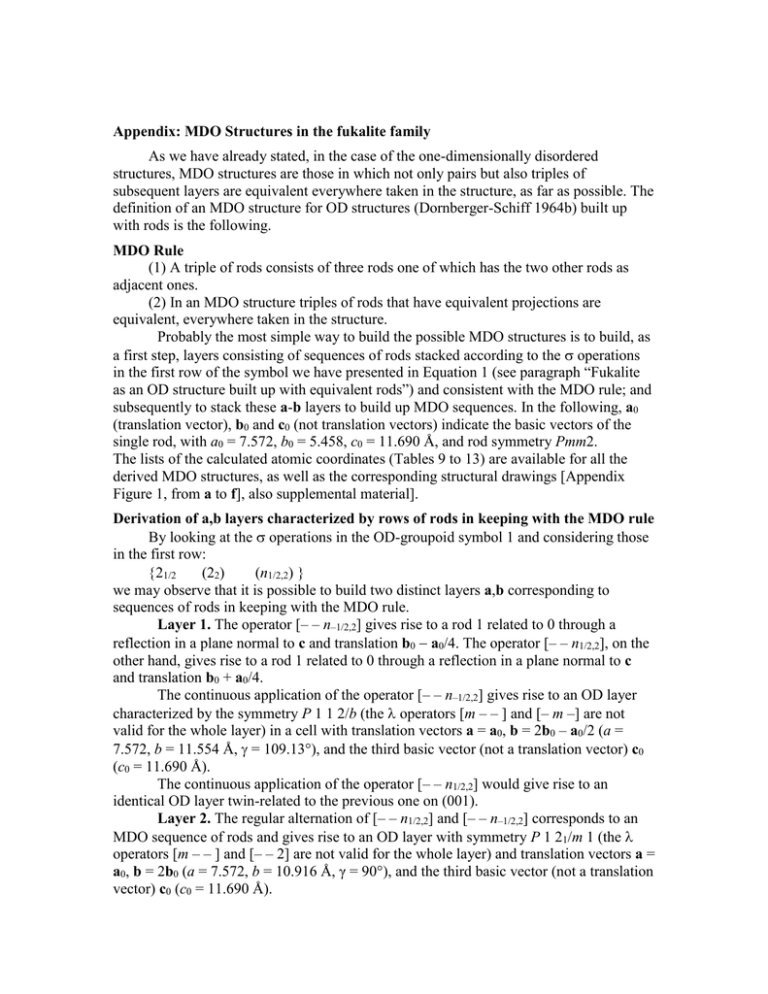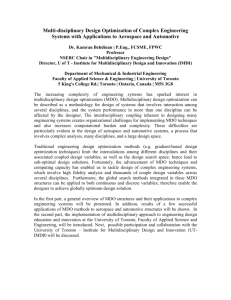Merlino_p323_09_Append.doc
advertisement

Appendix: MDO Structures in the fukalite family As we have already stated, in the case of the one-dimensionally disordered structures, MDO structures are those in which not only pairs but also triples of subsequent layers are equivalent everywhere taken in the structure, as far as possible. The definition of an MDO structure for OD structures (Dornberger-Schiff 1964b) built up with rods is the following. MDO Rule (1) A triple of rods consists of three rods one of which has the two other rods as adjacent ones. (2) In an MDO structure triples of rods that have equivalent projections are equivalent, everywhere taken in the structure. Probably the most simple way to build the possible MDO structures is to build, as a first step, layers consisting of sequences of rods stacked according to the operations in the first row of the symbol we have presented in Equation 1 (see paragraph “Fukalite as an OD structure built up with equivalent rods”) and consistent with the MDO rule; and subsequently to stack these a-b layers to build up MDO sequences. In the following, a0 (translation vector), b0 and c0 (not translation vectors) indicate the basic vectors of the single rod, with a0 = 7.572, b0 = 5.458, c0 = 11.690 Å, and rod symmetry Pmm2. The lists of the calculated atomic coordinates (Tables 9 to 13) are available for all the derived MDO structures, as well as the corresponding structural drawings [Appendix Figure 1, from a to f], also supplemental material]. Derivation of a,b layers characterized by rows of rods in keeping with the MDO rule By looking at the operations in the OD-groupoid symbol 1 and considering those in the first row: 21/2 (22) (n1/2,2) we may observe that it is possible to build two distinct layers a,b corresponding to sequences of rods in keeping with the MDO rule. Layer 1. The operator [– – n–1/2,2] gives rise to a rod 1 related to 0 through a reflection in a plane normal to c and translation b0 a0/4. The operator [– – n1/2,2], on the other hand, gives rise to a rod 1 related to 0 through a reflection in a plane normal to c and translation b0 + a0/4. The continuous application of the operator [– – n–1/2,2] gives rise to an OD layer characterized by the symmetry P 1 1 2/b (the operators [m – – ] and [– m –] are not valid for the whole layer) in a cell with translation vectors a = a0, b = 2b0 – a0/2 (a = 7.572, b = 11.554 Å, = 109.13°), and the third basic vector (not a translation vector) c0 (c0 = 11.690 Å). The continuous application of the operator [– – n1/2,2] would give rise to an identical OD layer twin-related to the previous one on (001). Layer 2. The regular alternation of [– – n1/2,2] and [– – n–1/2,2] corresponds to an MDO sequence of rods and gives rise to an OD layer with symmetry P 1 21/m 1 (the operators [m – – ] and [– – 2] are not valid for the whole layer) and translation vectors a = a0, b = 2b0 (a = 7.572, b = 10.916 Å, γ = 90°), and the third basic vector (not a translation vector) c0 (c0 = 11.690 Å). Derivation of the MDO structures: MDO structures built up with layer 1 The OD theory points to the following “OD groupoid family symbol” for layers with symmetry P 1 1 (21/b) as appropriate for the structural scheme of fukalite: 2 / b P 1 1 1 1 2 2 / nr 1, s which, with r = ¾, s = ½, becomes: 2 / b P 1 1 1 1 22 / n1 / 4,1 / 2 As the layer has a twofold axis parallel to c0, both n-1/4,1/2 and n1/4,–1/2 operations are possible. With the regular alternation of n-1/4,1/2 and n1/4,–1/2 the operator 22 is continuous through the OD layer, becoming a 21 screw axis in a structure with c = 2c0. It is the generating operation of the MDO1 with space group P1121/b, a = 7.572, b = 11.554, c = 23.379 Å, = 109.13° (Table 2; a drawing of the MDO1 structure is reported in Fig. 12a). After conversion to a standard setting the unit-cell dimensions are a = 7.572, b = 23.379, c = 11.554 Å, = 109.13°, with space group P121/c1. The continuous application of n1/4,–1/2 (or of n–1/4,1/2) gives rise to a triclinic MDO2 structure. In it, only the inversion centers (both and ) are operations valid for the whole structure. The generating operation is the translation c = c0 + b0/2. Therefore MDO2 has space group P1, with a = 7.572, b = 11.554, c = 12.004 Å, = 77.6°, = 90°, = 109.13° (Table 2, Fig. 12b; the calculated atomic coordinates are listed in Table 9). Derivation of the MDO structures: MDO structures built up with layer 2 There are two OD groupoid family symbols for layers with symmetry P 1 21/m (1). The first of them is here reported: 1 P 1 21 / m 1 2 s 1 / c2 1 which, with s = ½, becomes: 1 P 1 21 / m 1 2 1 / 2 / c2 1 As the layer has a mirror normal to b, both 2–1/2 and 21/2 operations are possible. With the regular alternation of 2–1/2 and 21/2, the operation c2 is continuous through the OD layers, becoming a glide c in a structure with c = 2c0. It is therefore the generating operation of the MDO3 structure, with space group P 1 21/c 1, a = 7.572, b = 10.916, c = 23.379 Å, = 90° (Table 2, Fig. 12c; the calculated atomic coordinates are listed in Table 10). The constant application of 2–1/2 (or 21/2) gives rise to a triclinic MDO4 structure. In it, only the inversion centers (both and ) are operations valid for the whole structure. Therefore MDO4 has space group P1, with a = 7.572, b = 10.916, c = 12.004 Å, = 103.14°, = 90°, = 90° (Table 2, Fig. 12d; the calculated atomic coordinates are listed in Table 11). There is another set of operations compatible with the operations of the layer with symmetry P 1 21/m (1) and the corresponding OD groupoid family symbol is here reported: 1 1 21 / m 21 / 2 / n1 / 2,2 1 2 2 / n1 / 2,1 / 2 Other MDO structures may be derived following the procedures just described. With the regular alternation of [– – n1/2,1/2] and [– – n1/2,–1/2] we obtain a structure (MDO5) with a = a0, b = 2b0, c = 2c0 – a0/2. The operation [– 21 –] is valid for the whole structure that presents space group symmetry P 1 21 1, a = 7.572, b = 10.916, c = 23.685 Å, = 99.20° (Table 2, Fig. 12e; the calculated atomic coordinates are listed in Table 12). The constant application of the operation [– – n1/2,1/2] gives rise to a B-centered triclinic structure (MDO6; a = a0, b = 2b0, c = 2c0 – b0), in which only the symmetry centers (both and ) are valid for the whole structure (a = 7.572, b = 10.916, c = 24.009 Å, = 103.14°, = 90°, = 90°). The reduced cell, with space group P1 may be obtained through the transformation matrix [1 0 0 / 0 1 0 / ½ 1 ½ ]: a = 7.572, b = 10.916, c = 12.587 Å, = 102.52°, = 107.50°, = 90° (Table 2, Fig. 12f; the calculated atomic coordinates are listed in Table 13). P Nomenclature for fukalite polytypes With the aim to deal with polytypes presenting multiple periods along two (or three) axes, a modified Gard (1966) system has been recommended by the IMA-IUCr Joint Committee on Nomenclature (1977) and confirmed by the Ad-Hoc Committee on the Nomenclature of Disordered, Modulated and Polytype Structures of IUCr (Guinier et al. 1984). “In this system the symbol to describe a polytypic phase consists of a mineral name and an italicised supplement, combined by a hyphen. The supplement contains four positions, with additional marks when necessary. The first position in the symbol is filled by (…) capital letters to indicate the crystal system of the compound (…). Three lowercase letters, accompanied by numbers where necessary, follow the symmetry symbol to indicate the periodicities along the three axes of the compound relative to those of the smallest subcell of the polytypic system” (Guinier et al. 1984). As in our case the smallest subcell (corresponding to the family cell) is orthorhombic with parameters: a = 3.786, b = 5.458, c = 23.379 Å, the six MDO structures in the fukalite family may be denoted as indicated in the Table A1. There are two MDO structures that present the same notation A2a2b2c. The pedices 1 and 2 have been added to indicate that the two structures are distinct [This is not unusual in the case of polytypes built up with layers (micas of type 2M1 and 2M2)]. The notation for fukalite from Gumeshevsk, MDO1 polytype, is therefore fukalite-M2a4bc. It is also proper to indicate the notation for the fully disordered specimens found at Fuka and Mihara by Henmi et al. (1977), namely fukalite-O2abdcd: in those specimens fully ordered rods running along a (a = 7.572 Å) are stacked in disorder in the b and c directions. Differences in fukalite samples It is now important to observe that the structure determined by Rastsvetaeva et al. (2005) has a very peculiar feature, namely that the polyhedral scaffolding has the structure represented in Figure 2 and therefore the silicate chains have a definite projection in the a-b plane. In other words a polyhedral scaffolding and a chain distribution as represented in Figures 12e and 12f are to be excluded in the specimen from the Urals. This observation limits the possible MDO structures that actually occur in the crystals of fukalite from the Urals. On the other side such a limitation does not occur in the specimens of fukalite studied by Henmi et al. (1977), which apparently display a higher disorder, not only as regards the double possible positions of the chains within the channels, but also in the distribution of the channels, which may follow the scheme of Figure 2 or the scheme of Figure 12e. In conclusion the specimen from the Urals, presenting a lower degree of disorder, seems more appropriate for a study of the real structure of fukalite and the results of such a study will be helpful also for understanding the real structure of the specimens from Fuka. Appendix Table 1. The six MDO polytypes of fukalite a b c α β γ S.G. notation Matrix MDO1 7.572 11.554 23.379 109.13 P1121/b M2a4bc 100/120/001 MDO2 7.572 11.554 12.004 77.6 90.0 109.13 P1 A2a4b2c 100/120/-½ –1 4 MDO3 7.572 10.916 23.379 90.0 P121/c1 M2a2bc 100/010/001 MDO4 7.572 10.916 12.004 103.14 90.0 90.0 P1 A(2a2b2c)1 100/010/014 MDO5 7.572 10.916 23.685 99.2 P1211 M2a2b2c 100/010/102 MDO6 7.572 10.916 24.009 103.14 90.0 90.0 B1 A(2a2b2c)2 100/010/012 Notes: The last column presents the matrices to transform from the setting of the given polytype to the “orthorhombic” setting corresponding to the notation. M and A indicate monoclinic and triclinic (anorthic) crystal system, respectively.





